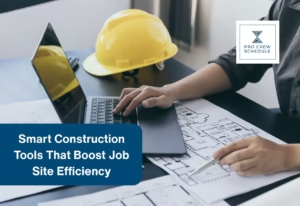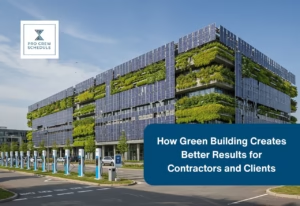For the past decades, a lot has changed in the construction industry. There were several trends built with the help of today’s technology and innovations, and these trends have helped the different sectors inside the construction industry to flourish and to become more efficient and effective. For the past years, there have been different varieties of builders’ trends that have made tasks in the construction industry easier. New technology has been continuously changing construction sites, raising project quality, and increasing profits. The different movements and trends in the construction industry have been altering and changing the roles of the experts and professionals in the field. From jobs such as general contracting, designing, installing electrical systems, plumbing, etc., technology, and innovation has been leaving a footprint.
Today, plenty of machine, tools, equipment, software, and techniques for the construction industry are continuously emerging:
Project Management Software
The variety of services in construction, together with the demand for project support using software are both on the rise. With the use of project management tools or software, both complex and trivial tasks that are taking up plenty of time can be done more efficiently and effectively. The task of subcontractors such as creating the builders’ schedule will become much easier with the help of such tools. Managing tasks, monitoring performance and attendance, sharing and sending files, and construction crew management as a whole will also become easier and more efficient.
Building Information Modeling (BIM)
Building Information Modeling or BIM is a digital characterization of a project which includes its physical and functional aspects. With the use of this technology, having a reliable basis for decisions regarding a project’s life cycle will become possible using less heavy steps. BMI could be a way to the evolution of how professionals manage, design, and develop construction projects. Using BMI will help make the building process more accurate, and the exchange of insights and information between the people involved with the project better. Also, it is expected to increase affordability and productivity because it involves an enhancement when it comes to safety measures and sustainability. BMI reduces risks and costs because possible concerns and problems during the physical construction on the construction site can be spotted and addressed during the digital pre-construction stage with the use of such technology. With the use of a 3D model, all parties involved with a project can track its progress and have access to the same data up-to-date.
Drones
In this modern time, plenty of construction sites are now using drones. Using drones in construction can save a lot of time and money. With drones, surveyors can inspect an entire project site within a few minutes, which in the past, can take weeks or even months. Also, drone technology is continuously improving in aspects such as the accuracy and precision of its readings which means that it will need less human involvement as time passes.
Robotics
Another trend in the construction industry today is robotics. As robots develop and become more precise and accurate, it is expected that the time will come that this technology will be able to start completing the tasks performed by people in the construction industry. The use of robotics becomes especially useful when the health and safety of the workers are at stake. Besides, using robotics can be a good way to fill in the lack of skilled workers. With continuous innovation and development, robots can become more precise and accurate, multi-talented, able to work at a high speed and work in different weather. Although this technology can be expensive, the durability, accuracy, and precision that it can offer will lead to the efficiency work quality.
Augmented and Virtual Reality
Construction sites can be accident-prone with different materials, equipment, and the site itself. But with today’s technology such as Augmented Reality (AR) and Virtual Reality (VR), construction crews can train better. With the use of these technologies, construction crews can simulate and train dangerous situations. Augmented Reality technology can be used to pinpoint and eliminate the risks on construction sites to prevent such situations from happening in reality. With the use of such technology, crews’ will be able to see whether construction materials are placed correctly, and will also be able to know what is behind plastered walls, ceilings, and floors.
GPS
Another latest trend in the construction industry today is GPS. GPS is used by construction crews in surveying. Using GPS, the necessary information from prospective project sites can be accurately accumulated in a shorter time. Also, GPS is used by project managers in fleet management. With the use of devices that can be attached to vehicles that can be tracked using smartphones and computers, everyone can know where the vehicles are. Through GPS, project managers will be able to easily locate stolen or lost machines or equipment because maps which can show the exact location of the items can be generated.
Safety Equipment
One of the most important aspect which should be considered when building projects in construction sites is safety. Today in the construction industry, the process of improving the standards when it comes to safety equipment and the used of better safety equipment is also a trend. This safety trend in construction uses technological advancements such as wearable technology and fitness trackers. Using these things, supervisors will be alerted if a part of the crew is too tired or has fallen. Other products of technology that are now available for the safety of the workers are cooling vests and moisture-wicking fabric.
CRM and ERP systems
Customer Relationship Management (CRM) and Enterprise Resource Planning (ERP) systems are also one of the trends in the construction industry today. These systems encourage better, faster, and more economical work. With the use of these two systems, resources will be handled better, and the processes in the business will become more efficient because data maintenance and double data storage will be avoided. ERP systems are designed to lessen the cost by being utilized in controlling business processes in every department. On the other hand, CRM systems are to retain customers and increase sales by being utilized in customer interactions.
Cloud and Mobile Technology
Another trend in the construction industry today is cloud and mobile technology. With these technologies, mobile devices can now store huge amounts of information that can be shared instantly. Also, these technologies made it possible for project managers to access and secure the data in a remote location. These technologies also promote better collaboration between construction teams when planning and building projects.
Blockchain Technology
Another construction trend in the construction industry today in blockchain technology. This technology which permits payments and other transactions to be performed without intermediaries is the basis of cryptocurrency. With this technology, transactions are recorded in blocks in a decentralized database which is reflected on other computers. This technology also simplifies the conclusion of contracts made digitally with its strong security because once the information has been linked in the chain, it will be stored permanently. Using this technology, in the field of construction, as shortly after staff has reported that his/her contract has been fulfilled using a mobile device on the construction site, the acceptance of work is realized, the inspector marks the order as complete, and the due invoice will be paid automatically.
Self-healing Concrete
Self-healing concrete is one of the trends in the construction industry today. Using this new technology, areas of concern in construction such as building cracks and structural deterioration will be better addressed. This technology can be used on homes, buildings, and roads, and can promote better efficiency and effectiveness.
3D Printing
Another trend in the construction industry today is 3D printing. Using this technology, today, a house can be printed in 24 hours. With this technology, robot arms are being used to apply layers of fast-setting concrete. Different materials such as concrete and glass fibers, concrete polymer foam, and metals such as stainless steel, aluminum, bronze, etc. can be used in 3D printing. This technology is also expected to acquire momentum and earn more market share.
Prefabrication and Modular Building
With prefabrication and modular building, the different elements of a structure can be built in a factory. Using prefabrication, a shorter time is the need for the construction which promotes efficiency. Also, the different elements of the structure are made with the highest quality standards and are made with higher speed and precision. Also, materials are being saved which promotes more resource-efficiency and sustainability.
Sustainable and Green Building
Sustainable building considers the conservation of the existing natural environment starting from the stage of planning for the project, and it aims to save as many resources and energy during the next processes. It is the idea of sustainable building that the structure that is built should go back to nature after it is used without leaving any trace or residue. To accomplish this objective, the conscious use of water, sophisticated energy concepts, and the process of meticulously selecting building materials are all necessary. Also, the concept of “Green Building”, together with “Ecological Building” aims to lessen the harmful effects of different processes on both the health and the environment.
There is a variety of trends in the construction industry today. These trends are created with continuous innovation and technological development, all meant to make the lives of people easier and to also preserve the environment. It is only right that we maximize these machines, equipment, and trends. But before using these to our convenience, we must first ensure that we fully understand how these things work, and should also always consider our own and others’ safety, and the environment to better utilize these trends.





